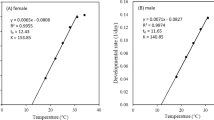Abstract
The courtship, mating and ovipositional behavior ofA. matricariae Haliday were studied. UsingMyzus persicae (Sulzer) as the host, the production of progeny per female parasite and survival from mummy stage to the adult were studied at constant temperatures of 10°, 12.8°, 15.6°, 18.3°, 21°, 24°, 26.7°, 29.5° and 32°C. The longevity of male and female parasites was determined at temperatures of 7°, 10°, 15.6°, 21°, 26.7°, 29.5° and 32°C. The greatest number of progeny (392) was produced at 21°C. The optimal temperatures for production of progeny and survival of the parasites during the mummy stage were from 12.8°C to 21°C. The longevity of male and female adult parasites decreased as temperatures increased and male parasites lived significantly (P<0.05) longer than females at 10° and 15.6°C.
Résumé
Les comportements d'accouplement et de ponte deA. matricariae Haliday sont étudiés. UtilisantMyzus persicae (Sulzer) comme hôte, la production de progéniture par parasite femelle et la survie du stade cocon au stade adulte sont étudiées à des températures constantes de 10°, 12,8°, 15,6°, 18,3°, 21°, 24°, 26,7°, 29,5° et 32°C. Le plus grand nombre de progéniture (392) est produit à 21°C. Les températures optimales pour la production de progéniture et la survie des parasites au stade cocon se situent entre 12,8°C et 21°C. La longévité des parasites adultes mâles et femelles diminue lorsque les températures augmentent et les parasites mâles ont une durée de vie largement supérieure à celle des femelles (P<0,05) à 10° et 15,6°C.
Similar content being viewed by others
References
Fox, P.M., Pass, B.C. &Thurston, R.—1967. Laboratory studies on the rearing ofAphidius smithi [Hymenoptera: Braconidae] and its parasitism ofAcyrthosiphon pisum [Homoptera: Aphididae].—Ann. Entomol. Soc. Am., 60, 1083–1088.
Haliday, A.H.—1834. Essay on the classification of parasiticHymenoptera.—Entomol. Mag., 79, 44.
Hart, J.T., Jonge, J. de, Colle, C., Dicke, M., Van Lenter, J.C. &Ramakers, P.—1978. Host selection, host discrimination and functional response ofAphidius matricariae Hiliday [Hymenoptera: Braconidae], a parasite of the green peach aphid,Myzus persicae (Sulz).—Med. Fac. Landbouww. Rijksuniv. Gent., 43, 441–453.
Hussey, N.W.—1965. Possibilities for integrated control of some glasshouse pests.—Ann. Appl. Biol., 56, 347–350.
Mackauer, M.—1968. Insect parasites of the green peach aphid,Myzus persicae and their control potential.—Entomophaga, 13, 91–106.
McLeod, J.H.—1936. Some factors in the control of the common greenhouse aphidMyzus persicae (Sulzer), by the parasiteAphidius phorodontis Ashm.—Annu. Rep. Entomol. Soc. Ontario, 67, 63–64.
Schlinger, E.I. &Mackauer, M.—1963. Identity, distribution and hosts ofAphidius matricariae Haliday, an important parasite of the green peach aphid,Myzus persicae [Hymenoptera: Aphidiidae—Homoptera: Aphididae].—Ann. Entomol. Soc. Am., 56, 648–653.
Scopes, N.E.A.—1970. Control ofMyzus persicae on year-round chrysanthemum by introducing aphids parasitized byAphidius matricariae into boxes of rooted cuttings.—Ann. Appl. Biol., 66, 323–327.
Shalaby, F.F. &Rabasse, J.M.—1979. On the biology ofAphidius matricariae Hal. [Hymenoptera: Aphidiidae], parasite onMyzus persicae (Sulz) [Homoptera: Aphidae].—Ann. Agric. Sc., 11, 75–96.
Stary, P.—1966. Aphid Parasites of Czechoslovakia.—Czechoslovak Academy of Sciences W. Junk, Publishers, The Hague, 242 pp.
Stary, P.—1970. Biology of Aphid Parasites [Hymenoptera: Aphidiidae] with Respect to Integrated Control. (E. Schimitschek ed.).—Entomol. Series Vol. 6,Junk, The Hague, 643 pp.
Tremblay, E.—1975. Possibilities for utilization ofAphidius matricariae Hal. [Hymenoptera: Ichneumonoidea] againstMyzus persicae (Sulz). [Homoptera: Aphidoidea] in small glasshouses.—Z. Pflanzenk. Pflanzenschutz, 81, 612–619.
Vevai, E.J.—1942. On the bionomics ofAphidius matricariae Hal., a braconid parasite ofMyzus persicae (Sulz).—Parasitology, 34, 141–145.
Vinson, S.B.—1978. Courtship behavior and source of a sexual pheromone fromCardiochiles nigriceps.—Ann. Entomol. Soc. Am., 71, 832–837.
Wheeler, E.W.—1923. Some braconids parasitic on aphids and their life history.—Ann. Entomol. Soc. Am., 16, 1–29.
Wyatt, I.J.—1970. The distribution ofMyzus persicae (Sulz.) on year round chrysanthemums. II. Winter season. The effect of parasitism byAphidius matricariae Hal.—Ann. Appl. Biol., 65, 31–41.
Wiacknowski, S.K.—1960. Laboratory studies on the biology and ecology ofAphidius smithi Sharma & Subba Rao.—Bull. Acad. Polon. Sci. (B. Ser. Sci. Biol.), 8, 503–606.
Author information
Authors and Affiliations
Additional information
This paper is published with the approval of the Director of the Kentucky Agricultural Experimental Station as Journal Article no 79-7-182.
Rights and permissions
About this article
Cite this article
Giri, M.K., Pass, B.C., Yeargan, K.V. et al. Behavior, net reproduction, longevity, and mummy-stage survival ofAphidius matricariae [Hym. Aphidiidae] . Entomophaga 27, 147–153 (1982). https://doi.org/10.1007/BF02375222
Issue Date:
DOI: https://doi.org/10.1007/BF02375222




